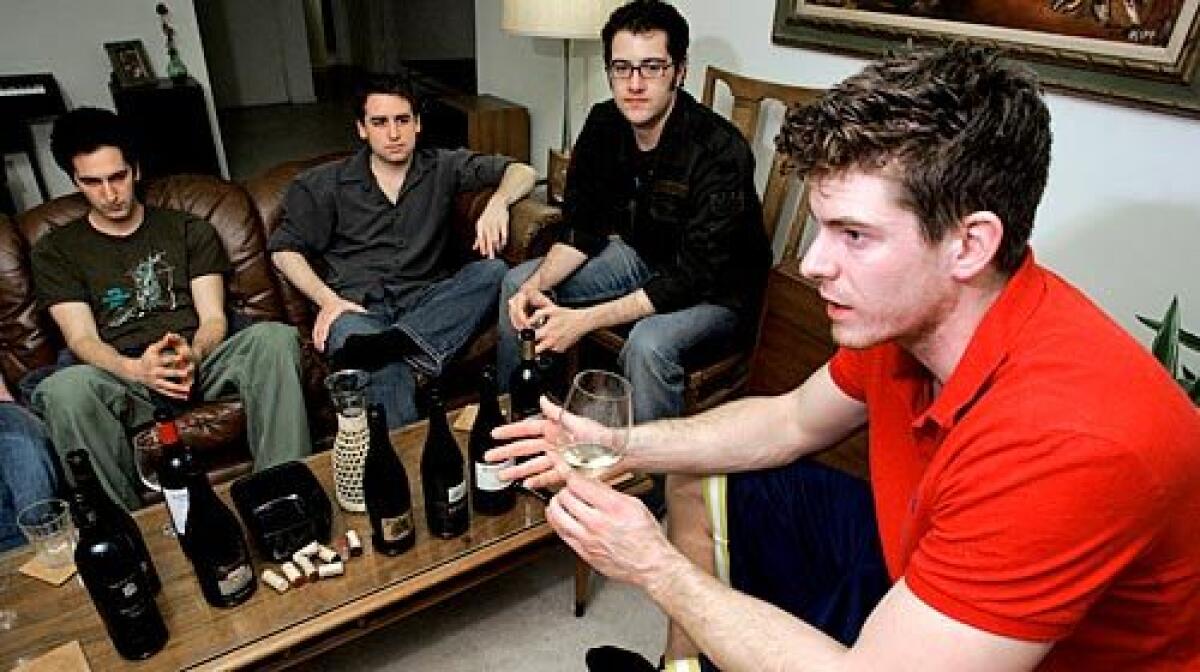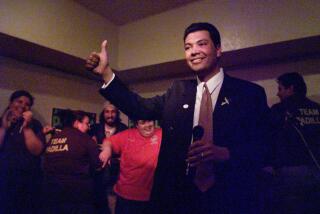Young Winos: The Millennial generation is a thirsty one

WHAT do you call a weekly wine tasting group made up of 21- to 29-year-olds? They call themselves the Young Winos of Los Angeles. The wine industry calls them its future.
The Young Winos, along with other twentysomething adults across America, are the new driving force in the wine market, says Patrick Merrill, a San Mateo-based wine market researcher. When it comes to wine, they drink more, know more, spend more and enjoy a broader international selection of wines, on average, than any generation before them.
FOR THE RECORD:
Alma mater: In a March 12 Food story about a wine tasting group [“They’re Young —and Thirsty,” by Corie Brown], Young Winos founder Jesse Porter was misidentified as a graduate of Syracuse University. He is an Ithaca College graduate.
And if this love affair continues, they will reshape wine in their open-minded, information-hungry, unpretentious image, according to a growing body of market research.
Jesse Porter was a 22-year-old Syracuse University graduate working long hours in L.A. as an assistant to a husband-wife filmmaking team when he stapled a few fliers on UCLA bulletin boards and posted an online invitation to other young Angelenos to form a wine-tasting group. He had plenty of takers.
Now, 2 1/2 years later, a core group of two dozen members makes it to most of the Young Winos’ weekly tastings along with occasional attendees from among an additional 100 people on the group’s e-mail list. Every other month a fresh posting on Craigslist brings in new blood.
The members are serious about improving their wine IQs, and the Wednesday night meetings rarely disintegrate into parties. But the conversation often wanders from what’s in the glass.
At a recent meeting in Sherman Oaks, Porter ran a hand through his hair as he pushed the group to focus on the subject at hand, a 2005 Sutton Cellars Carignane from Mendocino County.
“We can talk about politics later when we pull out the cheese, but let’s focus on the nose here. What do you smell?” he asked the 15 Young Winos gathered in his living room.
The group snapped its attention back to the wine. “Smoky,” “smells like cherries” and “I get maple syrup,” members said in turn before taking their first sips -- and collectively gagging.
“Oh, my God!” one member said. “Sour barbecue sauce that feels like burning embers all the way down your throat” was another’s description of the wine. The cri de coeur of “the most disgusting wine I’ve ever drunk!” persuaded Porter to call for the dump bucket.
The theme of the tasting was “Old World Red Varieties Grown in the New World,” with Cabernet Sauvignon, Merlot, Pinot Noir and Syrah off-limits. The next wine was a Cabernet Franc from New York’s Finger Lakes region. Then they opened a Petit Verdot from California’s High Valley Vineyard. Neither was a winner. Their conclusion: There is a reason these are considered “blending” grapes on their home turf.
But when they pulled the cork on a Malbec-dominated blend from Argentina, the oohs and aahs began. South American wines score well with this group, whose members tend to buy wines priced $10 to $20 but will often stretch for a $30 wine.
“None of us has money to throw around,” Porter says.
The Bordeaux and Burgundy wines they’ve tried in their price range have been disappointing enough that they avoid them now. “California,” Porter says, “is hit or miss.”
New -- and different
THESE new wine drinkers, often referred to as the Millennial generation, “believe all of the cool stuff from around the world was made for them, and that includes wine,” says John Gillespie, director of the industry’s Wine Market Council, who also researches wine-drinking habits through his firm, Wine Opinions.
Unlike baby boomers -- whose first wines were then-inexpensive California wines and who, in large part, continue to stick with the state’s brands -- local loyalties mean nothing to this group. With quality wine no longer the exception worldwide but the rule, this new generation buys wines from anywhere and everywhere. They focus on the best value they can find within their limited budgets.
The Millennials popped onto the wine industry radar in 2003 as drinkers remarkably different than those of previous generations. They like to learn through experience, by drinking instead of reading or tracking point scores from big-name critics such as Robert Parker. They glean information through Internet search engines rather than from books, magazines and newsletters aimed at people who aspire to be collectors. “They don’t go for any of the folderol,” Gillespie says.
The statistics bear that out, he says. Of the wine purchased by the 70 million Americans ages 21 to 30, 40% is imported. That purchasing tendency has been credited with pushing the rate of growth in sales of imported wines ahead of domestic wines, Gillespie says. Gen-Xers (the 45 million people ages 31 to 44) buy imported wines 32% of the time, whereas imports account for only 26% of wine purchased by 77 million baby boomers.
When Porter e-mailed the membership about the recent tasting (the evening was titled “Red Scare”), he directed people to websites for research. Among them was Gary Vaynerchuk’s Wine Library TV video blog (tv.winelibrary.com), a favorite site among members of the group (see related story).
Though Porter keeps a copy of Karen MacNeil’s “The Wine Bible” in his lap for quick reference during the tastings, most Young Winos say they usually just do an Internet search for the wine region or varietal they are interested in and check out links until they find the information they want.
That’s typical of this generation, Merrill says. People such as Vaynerchuk are increasingly influential as this generation buys more wine online. But it’s the advice of peers and their own taste that they trust most. “There is very little cockiness,” Merrill says. “Even the most knowledgeable among them will underestimate what they know. With older wine drinkers, the tendency is to overestimate what they know.”
Millennials take disappointing wines in stride. And even when they find a wine they love, they aren’t likely to buy a case of it, Merrill says. Tomorrow they expect to find a new wine they’ll like just as much or more.
Taking risks
AGAIN, the statistics tell the story. Boomer wine drinkers play it safe; surveys indicate that 4 out of every 10 bottles they buy represent “favorite” wines. This younger group takes risks, relying on “favorite” wines for just 1 in 10 of their wine purchases.
“They are ruled by the joy of discovery,” Gillespie says. So far, the industry has reached out to them with what he calls “fun” brands, priced $10 to $15, some with appealing animals on the label (sometimes called “critter wines”), others with funny names such as Oops and Red Truck.
The Millennials’ openness to new packaging has been a boon for screw caps as well as for boxed wines and other nonglass containers. Eventually, however, the industry will have to listen to what this group is saying about quality and value, Gillespie says. “We are entering a time when the consumer won’t be following but leading.”
It surprises Porter to learn that the Young Winos are representative of anything beyond the immediate group. “Wine is a pleasure,” Porter says. Knowing which wines on a restaurant’s wine list are bargains, being a smart shopper at BevMo or any of the other discount stores frequented by the Young Winos, “just dealing with wine in an intelligent way,” he says, is fun. “There is an absolute appeal to being able to pick wines you know you will like, even if you can’t spend much money.”
The group’s appreciation for wine has grown during the months its members have been tasting together. But rather than claiming the group has become more sophisticated, Porter says that the increased knowledge makes tastings more meaningful. The group wastes less time going over basics.
On its website (www.youngwinosofla.com), the group has started posting tasting notes from the meetings. Sasha Kopas, 25, who’s in charge of writing the notes, was losing patience with the “Red Scare” tasters. By 11 p.m., it was close to impossible to get explicit descriptions for the wines.
“I need two words, just two words,” she insisted. “Hard-boiled eggs on the finish,” one member said. “An odd, pleasing sweetness that’s not sweet,” opined another.
Kopas joined the group a year and a half ago and now attends nearly every tasting. “I was looking for a running club after I moved here from D.C. and this popped up on Craigs- list. I thought ‘wine tasting’ sounded swanky,” she said. Jason Meltzer, 29, says he was “a desperate and lonely engineer” when he discovered the group.
“We all believe that there should be a decent bottle of wine on every dinner table. It’s a proletariat ideal,” Porter says.
More to Read
Sign up for our L.A. Times Plants newsletter
At the start of each month, get a roundup of upcoming plant-related activities and events in Southern California, along with links to tips and articles you may have missed.
You may occasionally receive promotional content from the Los Angeles Times.






